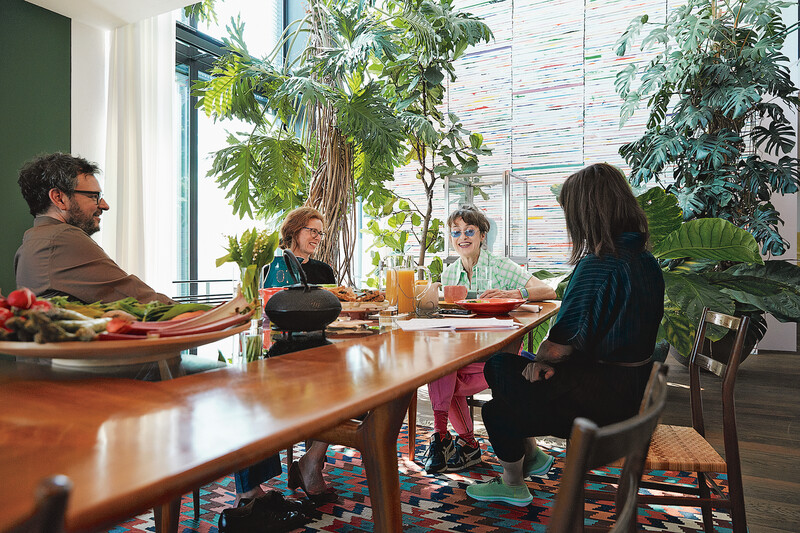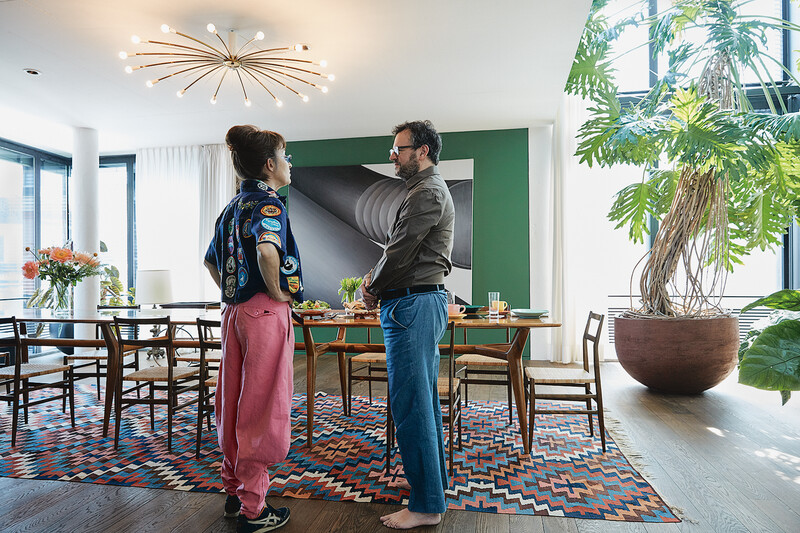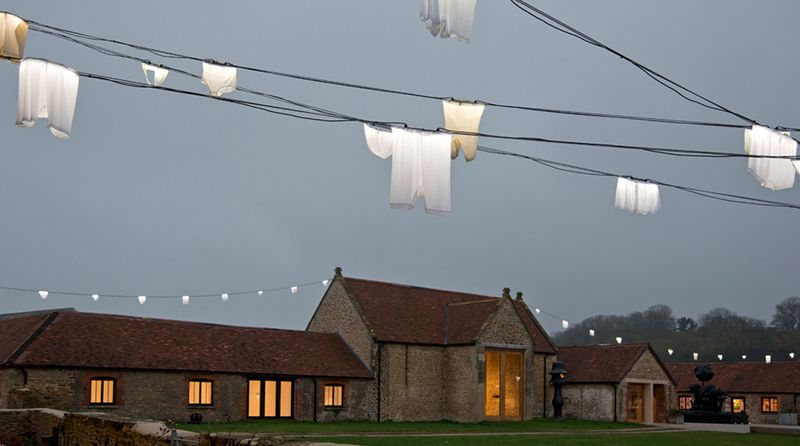Conversations
Pipilotti Rist, Manuela Wirth, and Iwan Wirth in conversation with Ewa Hess
The Dream

Iwan Wirth, Manuela Wirth, Pipilotti Rist, and Ewa Hess in Zurich, 2018. Photo: Martin Stollenwerk
The dream always manifests itself ad hoc, but in fact, it was already in the dreamer’s head. It emerges from the past, out of the fertile humus of memory, gets its energy from the present, and often bursts into flower in the future. Sometimes we can only measure the full impact of a dream in retrospect. This is what we find ourselves trying to do on this sunny spring day in Zurich, as we draw a thin, barely visible line between the towns of Oberuzwil in Switzerland and Bruton in South-West England.
We meet in Zurich because it fits into the geographically complex schedules of the interview’s participants. The lives of Manuela and Iwan Wirth pulsate between eight Hauser & Wirth galleries on three continents. Pipilotti Rist has been dividing her time between two large exhibitions: one, which has just ended, in Sydney, and another which is opening next year at Denmark’s Louisiana Museum of Modern Art. On the large table in the Wirths’ Zurich living room sits a bowl of salad, vegetarian whole-grain sandwiches, and a dish of Spanish almonds. Iwan Wirth greets his guests bare-footed, as a hike on Sunday left him with blisters. ‘Are we talking about a dream or more of a utopia?’ The man with the blisters on his feet is also a fan of verbal precision.
However, the first topic under discussion isn’t the origin of the idea for Durslade. Instead, we are focussed on risotto, one with nettles, as Anna Del Conte’s memoir Risotto with Nettles is due to be presented at Durslade the following day. As our conversation later reveals, the risotto and the nettles are both thoroughly part of the Durslade utopia, which is, as Iwan puts it, ‘an energy centre, in which a great permeability prevails between the art, the gallery, the kitchen, and the town.’ Thanks to Anna Del Conte, we catch a snippet of the Wirths’ pillow talk. In the evenings, before going to sleep, Manuela reads cookbooks in bed. As Iwan tells us, ‘She reads recipes and then says: Oh my God, that is so insane!’ Manuela laughs, ‘My husband says I’m perverse, reading cooking recipes in bed.’ ‘I couldn’t do that, I’d get hungry,’ Iwan jokes.
Anna Del Conte brought high-quality Italian cuisine to England seventy years ago, and now – by a stroke of serendipity – she lives in Somerset. Tomorrow, when Del Conte presents her memoir, Manuela will do the introduction before cooking commences in the Durslade kitchen using Del Conte’s recipes. This is a typical Hauser & Wirth Somerset event. Let’s go back to the beginning. How did it all get started? ‘With our children climbing on trees in a park in London, there it was right away: you aren’t allowed to do that!’ says Iwan. ‘And when we wanted to rent a house near London, they said there, too, that our kids couldn’t build a treehouse in the garden,’ Manuela adds. The Wirths quickly realised what this meant: they had to move to the countryside. So, they moved west and bought a farmhouse in Bruton.
In hindsight, Somerset seemed like the only real choice – it’s not all that far from London, yet too far to commute. It’s a place with a life of its own. ‘There aren’t any manor houses like in the Cotswolds,’ explains Iwan. We realise that he sees this as an advantage – Somerset isn’t stately enough for the fashionable jet set. ‘Seen historically, Somerset is a place of retreat for the upper middle class; a green region with a farming economy that’s still operational. The aristocracy rarely visited because it was usually too wet to hunt.’ ‘Hippies settled in the area after the Glastonbury Festival’ adds Pipilotti. She wrote down observations about Bruton’s residents during the year she spent there: ‘Artists, writers, alchemists, esteemed eccentrics, and grassroots locals. And, of course, lots of farmers, whose fields are harvested by Polish seasonal workers. A fantastic mix!’

Pipilotti Rist and Iwan Wirth, 2018. View of Lee Lozano, Veer, 1964 in background. Photo: Martin Stollenwerk
Pipilotti’s stay in Bruton marked a phase when the Somerset project had already progressed through two developmental stages. At first, it was just a weekend house for the young Wirth family, an old farmhouse outside the little town. After a few years of splitting their time between London and Bruton, the entire family succumbed to the austere charm of the region, and they promptly relocated. When Iwan’s father, an experienced Swiss mountain guide, visited, he looked out across the gently rolling landscape towards King Alfred's Tower, surveying the panorama of small agrarian farmsteads and said, in a tone of reserved approval, ‘It looks a lot like where we live.’ Pipilotti’s laugh confirms this perception, ‘Bruton is quite similar to the St. Gallen backcountry in Switzerland, where all three of us come from.’
And just as Oberuzwil, the name of their home village, comes from the small Uze River which runs through it, the name Bruton is derived from Somerset’s River Brue. Pipilotti turns to Iwan and Manuela: ‘You’re country people who’ve moved back to the country. You have respect for what’s there; that’s why you’ve been so well accepted.’ Similarly, whereas city children often opt to spend their time in front of the television or playing video games during country weekends planned by their parents, the Wirths’ children have from the outset been happy to play in the mud, gather wood in the forest, and build small dams in nearby streams. In fact, the Wirths’ first love was not Durslade; it was the landscape surrounding it. As Manuela describes, ‘the farm was quite run-down. With its asbestos-contaminated outbuildings, it didn’t make a very welcoming impression.’
But the couple did feel an immediate connection to the area, particularly ‘the forest and the river,’ as Iwan reflects. Manuela adds, ‘There is magic in this landscape; the green tunnels of the hedges give it a hint of mystery.’ This comment immediately unfolds into a discussion about the design of the hedges: When are they pruned? How are they best grown? Which is better: hawthorn or hazel bush? What sort of wildlife live in them? ‘Birds,’ Manuela responds, ‘insects,’ says Pipilotti, ‘hedgehogs,’ adds Iwan. And then they all rhapsodise about the sky, which is strikingly starlit by night, as the hedges swallow the lights of the passing cars. But the dream. We try to determine when the idea of the ‘energy centre’ finally germinated. Everyone looks around at one another. ‘It was just logical,’ Manuela begins. Iwan continues, ‘Our farmer thought we should acquire a farmstead, which would make management more efficient.
And we needed an office.’ Manuela adds, ‘and the farmhouse was too small to have guests.’ They drove by the picturesque old farm ruins again and again (‘The guesthouse’s Gothic windowpanes were stolen from the monasteries during the Reformation,’ Iwan smiles). At some point, it became clear: they needed a space where artists could work, a studio, a guesthouse, and a place where they could show art. ‘But who’s going to come?’ Manuela worried. ‘And where would the artists and the visitors eat?’ This is how Durslade slowly emerged as a possibility. When the community turned down an architectural development project that would have replaced the old farm, the Wirths saw it as a sign. Their vision was already quite evolved, and they began taking steps to realise it.
The old farm was to become an art centre: a place for artists and visitors to be re-energised. Importantly, the local community could directly profit from the activities of these new arrivals. The Wirths came from Switzerland, and democracy was in their blood. They were unwilling to plan without a broad consensus from the locals. ‘ If the Brutonians didn’t want to have our gallery, then we wouldn’t have done it – it’s as simple as that,’ says Iwan, whose family comes from Appenzell, a town in northeastern Switzerland where political decisions are still made by a show of hands at the cantonal assembly.
‘We see Hauser & Wirth Somerset as a single, cohesive entity; everything that happens there belongs to one large ensemble.’
In Zurich, coffee is being served. Pipilotti is nibbling on the almonds, as Manuela laughingly recalls the hedgelayer who asked the leading question at Durslade’s first village meeting: ‘What about the hedgehogs?’ Once it was explained that art folk also love hedgehogs, and once the assembly was able to move beyond the dispute between the hedgehog and badger preservationists (badgers are a natural predator of hedgehogs), the road towards Durslade was paved. ‘We were fortunate to be able to send ahead two great ambassadors for our case,’ says Iwan. The first was Piet Oudolf, a god among landscape gardeners. Nobody can resist the beauty of his naturalistic gardens, least of all any Brit.
Ambassador number two was now sitting with us at the table: Pipilotti Rist, the first Bruton artist-in-residence. ‘Pipilotti was a door-opener, an international artist who isn’t an aloof grandmaster in the studio; she’s someone who was naturally very present in the village,’ explains Iwan. Pipilotti’s son attended the local school, and she participated in the parents’ council. ‘I loved these people right away,’ says Pipilotti. ‘Everything affected me like lived literature. The way people speak with one another – the humour, the figures of speech, the Somerset accent; I found all of that great.’ The artist actually wanted to take a hiatus during her year in Bruton. ‘Officially, I said: I’m taking a year-long sabbatical. But apparently, I don’t know how to do that.’ Nature was too enticing not to be filmed.
Rist’s first subject was a young farmer on the estate whose calloused hands had ‘haptic intelligence’ and a ‘rough grace’. She filmed him caressing flowers. And when the Wirths’ eldest son – who was then often found exploring the world aided by a metal detector – discovered an old rubbish heap with ancient glass shards and small bottles, a joint work emerged. ‘We hung the found objects from the ceiling in the guesthouse using fine copper wire and had the projected film shine through them,’ Pipilotti recalls. The artwork from that collaboration is still there today. When one speaks of these somewhat improvised and euphoric beginnings, does something like nostalgia set in?
Now that Durslade – with the gallery, the restaurant, Roth Bar & Grill, the extensive event and education programme – is the largest employer in the region, with over 140,000 annual visitors (Bruton itself has 3,000 residents), do they perhaps miss the original, uninhabited version of the property? ‘We didn’t imagine that it would be such a success,’ Iwan says. ‘We’re now part of the landscape.’ Pipilotti chimes in, ‘I always hear people talking about “our Durslade,” that’s good karma.’ ‘For us,’ Iwan adds, ‘Hauser & Wirth Somerset has also become important in another sense. We have a different public in Durlsade with a different sensibility. That helps us because it allows us to open up a space for contemporary art that reaches beyond a metropolis.’

Pipilotti Rist, Mary Down Up, 2013. Installation view, Durslade Farmhouse, Hauser & Wirth Somerset © Pipilotti Rist

Pipilotti Rist, Hiplights (or Enlighted Hips), 2011. Installation view, ‘Stay Stamina Stay’, Hauser & Wirth Somerset, 2014 © Pipilotti Rist
Is it solely about art? ‘It’s about the overall connection,’ says Manuela. ‘It’s about the art outreach for children and the family tours on Saturday mornings. Young people who are interested in art often form their own groups; we have young people leading other young people through the exhibitions.’ ‘Or children leading the parents,’ Pipilotti adds. Iwan is already doing the maths: ‘We have eight galleries around the world. If I add up all the outreach offerings and subtract the days the galleries are closed, then we have on average [a brief pause] two events per day!’ ‘And the majority take place in Durslade,’ says Manuela. ‘And in Los Angeles,’ Iwan adds, ‘where we’re able to apply many of the concepts that we first try out in Bruton. Somerset is our laboratory.’ It turns out that Bruton became a such an important part of the Hauser & Wirth universe because it isn’t a picture-perfect idyll; after all, neither is the art that Hauser & Wirth represents.
We’re discussing Paul McCarthy’s Ship of Fools, Ship Adrift (2009–2010), a dark and grotesque allegory of a dysfunctional society which occupied Durslade’s courtyard in 2014–2015. ‘Great art is never easy,’ Iwan asserts, ‘and we haven’t made it easy for ourselves either. It’s not a question of size, but one of complexity. It’s about bringing diverse interests together under one roof.’ ‘And about taking on responsibility,’ Manuela adds. ‘We see Hauser & Wirth Somerset as a single, cohesive entity; everything that happens there belongs to one large ensemble,’ says Iwan. ‘It was clear to us from the outset that we would also keep animals, that we would plant vegetables,’ Manuela explains. That’s how it came to be that Roth Bar & Grill serves organically grown produce from its own garden and sustainably raised meat from its own pastures. ‘We see ourselves as custodians of the forest, water, and land,’ Iwan says, ‘and want the community to profit from that.
Currently, we’d like to expand on this and are thinking about distributing our farm products, such as our beef, which comes from a cross between Aberdeen and Wagyu cattle.’ At Durslade, the joy of eating is also seen as an art. ‘We believe in what’s local,’ says Iwan. Manuela nods. One notices a common thread between this approach to food and art at Durslade: global and local belong unwaveringly together. The English landscape, international art, Piet Oudolf’s garden, the fruits of the fields, the well-maintained cattle, the authentic cuisine, the commitment to the local community, not to mention Pipilotti and Elias Wirth’s installation of found objects – these are the true elements of Hauser & Wirth Somerset. A total work of art, a Gesamtkunstwerk – this is what the Wirths first dreamt about, even if they didn’t know it at the beginning.
